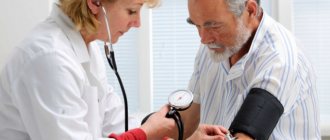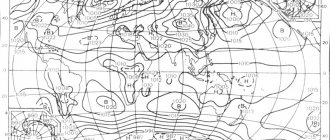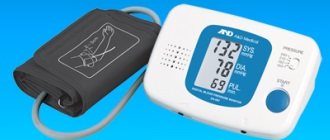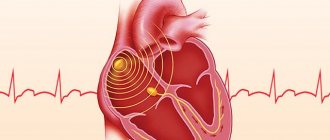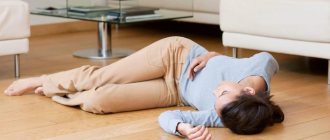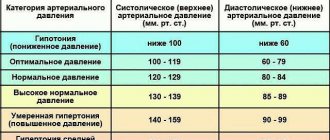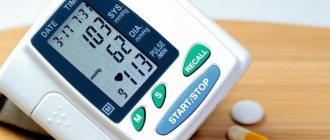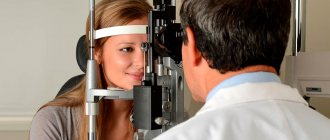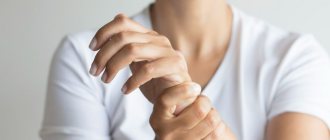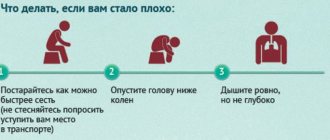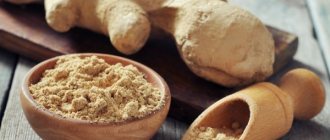Why is low blood pressure in an elderly person no less dangerous than high blood pressure?
Both conditions are dangerous - hypotension and hypertension. Doctors cannot give a definite answer as to whether high blood pressure or low blood pressure is worse. For a long time, there was an opinion that only high blood pressure is dangerous, since it puts a serious strain on the heart and this negatively affects its functioning. That is why older people with hypertension are often diagnosed with cardiovascular diseases, and they often suffer from strokes, heart attacks and other complications.
However, very low blood pressure in an elderly person is no less dangerous - with a lack of oxygen, the brain, heart, kidneys, and gastrointestinal tract cannot function normally. The result is the gradual death of organ cells.
Complications of hypotension include:
- Injuries sustained by older people during fainting conditions. They are often very strong.
- Ischemic stroke. It becomes a consequence of chronic lack of blood supply.
- Cardiogenic shock, myocardial infarction. Occurs when there is insufficient blood supply to the heart.
- Senile dementia (dementia). Develops as a result of a disturbance in the thought process due to frequent changes in blood pressure.
- Loss of sensation in limbs in older people. It becomes a consequence of disruptions occurring in the venous and arterial blood supply.
Hypotension that lasts for a long time can cause severe arterial hypertension.
We recommend
“Vitamins for elderly people over 70: which ones are needed first” Read more
Blood pressure 90/60 hypotension or maximum permissible norm
Although the maximum acceptable norm for blood pressure is considered to be 100/60, indicators of 90/60 can also be considered physiological or adaptive if a person does not lose the ability to work, does not have complaints, and feels comfortable.
If negative symptoms appear: headaches, faintness, weakness, fatigue, you should consult a doctor.
Most often, hypotension is recorded in:
- athletes;
- teenagers;
- pregnant women;
- during menopause;
- during acclimatization.
There is no need for special treatment if there is no discomfort.
Causes of low blood pressure in older people
Low blood pressure in older people can be either a primary, underlying disease or a symptomatic consequence of other diseases. Primary hypotension is called when this condition is not accompanied by other diseases. Otherwise, we are talking about symptomatic hypotension.
Many people are interested in why low blood pressure occurs in an elderly person, what is the cause of this condition. It is difficult to figure out what to do when diastolic pressure is low. The causes in older people directly depend on the type of hypotension. The acute form is a consequence of heart attacks, blood loss, intracardiac blockade, severe arrhythmia, and an allergic reaction. In case of acute hypotension, it is important to provide first aid to the person in a timely manner.
Primary hypotension is an independent disease manifested in the form of neurocirculatory asthenia.
Physiological hypotension is a hereditary disease; in other words, it is the body’s predisposition to low blood pressure. An elderly person is already accustomed to this condition, and since the readings are not much lower than normal, they are practically the norm for low blood pressure in older people.
The main reason for low blood pressure in an elderly person is prolonged psycho-emotional stress, which gives rise to neurosis of the vasomotor centers of the brain. Severe stress, in which a person is under for a long time, causes a drop in pressure, and, as a result, primary hypotension. It is also possible that this disease may develop due to an overdose of medications for hypertension. Another cause of hypotension is a lack of vitamins B5, C, E.
Causes of primary hypotension:
- frequent neuroses;
- psychotrauma;
- chronic lack of sleep and fatigue;
- depressive states of a person and apathy towards everything.
Causes of symptomatic hypotension:
- stomach ulcer;
- arrhythmia;
- rheumatism;
- anemia;
- cervical osteochondrosis;
- problems with blood circulation;
- heart failure;
- hepatitis, etc.
We recommend
“First aid for the elderly: what you need to know about it” Read more
Norm and deviation
Blood pressure 90/60 – what does this mean? The doctor receives information about blood pressure based on the indicators determined by the tonometer. The first number is systolic (upper) - indicates the time of contraction of the heart muscle. The second - diastolic (lower) - shows the pressure of the blood during the period of its pushing into the arteries.
Important! Doctors take 120/80 mm as the physiological norm. rt. Art.
Blood pressure levels can fluctuate and largely depend on a person’s current emotional and physical state. If blood pressure drops only periodically, then there is no cause for concern. But if low pressure is a constant condition, then it is necessary to find the reasons for such a deviation.
In some cases, the blood pressure level is 90(99)/60(66) mm. rt. Art. is considered by doctors as the norm. This statement applies to people with an asthenic body type, teenagers. In addition, many women feel great with this level of pressure.
Another group of people whose “working” blood pressure is 110(120)/70(80), if it decreases to the level of 90/60, begin to experience unpleasant symptoms. In this case, it is necessary to consult a therapist.
Critical low blood pressure in an elderly person: first aid
Low diastolic pressure in older people is a dangerous condition, so the first thing to do is call an ambulance. While waiting for medical workers, if the patient has already lost consciousness or it seems that this may happen to him, it is necessary to provide assistance independently, in particular:
- put the elderly person on his back;
- open a window to provide access to fresh air;
- unbutton the shirt collar to free the chest area and neck from clothing;
- if the person is conscious, give him drops for hypotension;
- do a rubbing massage in the direction from the ankles up.
Medicine that is recommended for low blood pressure in older people is not always at hand, so you can use improvised means - give the person strong coffee, give 2 tablets of caffeine-containing citramon. But you should definitely check whether the patient with low blood pressure has heart disease and whether he can use blood thinning medications.
You can help a person in such a situation and slightly increase blood pressure by using acupuncture. Find a point under your nose, press it with your finger, hold for a minute, release and repeat similar manipulations 5 to 10 times. Another way is to raise a person’s legs above his head, for example, by throwing them over the headboard of a bed or sofa, placing high pillows under his feet, etc. All this can be done while waiting for the doctors to arrive. Doing this will help prevent loss of consciousness due to low blood pressure and potential injuries from falling.
We recommend
“Caring for the elderly in Russia and abroad” Read more
Signs of low blood pressure
A decrease in pressure to a level of 70 to 40 (70/50) may be accompanied by unpleasant symptoms. These include:
- general lethargy, drowsiness;
- poor memory and concentration;
- the occurrence of tinnitus or congestion;
- cold extremities, chilliness;
- sweating of palms and feet;
- “flies, stars” before the eyes;
- pain in the back of the head;
- dizziness;
- loss of consciousness;
- feeling of interruptions in heart rhythm.
In some cases, hypotension can cause digestive disorders, menstrual disorders in women, and erectile function in men.
Doctors are not inclined to consider hypotension an independent disease; it is classified as a symptom of internal pathologies of the body. Sometimes the cause of its occurrence cannot be determined. In this case, they talk about idiopathic hypotension.
How to increase low blood pressure in an elderly person at home
If your blood pressure suddenly drops, but the readings are not critical, do not panic. We will tell you how to increase low blood pressure in an elderly person at home.
- One of the simplest and most widely known ways to increase blood pressure is to drink strong coffee. Caffeine helps dilate blood vessels and helps give the body a boost of energy. The drink helps especially well those older people who drink it rarely, about once a week. For those who drink coffee every day, it will be more difficult, because... It will not be possible to obtain the desired effect with low blood pressure if the body is already accustomed to caffeine.
- Strong sweet tea will help raise blood pressure and tone the body.
- Regular salt will come to the rescue. By eating something salty or even just putting a little salt on the tongue, an elderly person can alleviate his condition.
- Honey combined with cinnamon is considered one of the fastest ways to increase low blood pressure, and the effect remains for a long period. Take half a teaspoon of cinnamon and dissolve it in a glass of boiling water, add one spoon of honey. Wait half an hour for the drink to infuse, after which you can drink it. Or you can make it simpler: spread honey on a piece of bread, sprinkle cinnamon on top and eat this sandwich.
- You can eat something fatty, of course, it is better not to eat fatty foods too often, but if there is no other way to cope with a sharp drop in blood pressure, then you can use this one.
- Consuming glucose or refined sugar will also help raise your blood pressure. Glucose is sold in pharmacies in tablets.
- Cognac or red wine, but it is important to know the limit - no more than 50 grams per day. Usually cognac is added to coffee or tea.
We recommend
“Service for the elderly: forms, types and features” Read more
What needs to be examined?
Diagnostic measures for a person with low blood pressure are very complex. Consultations with a neurologist, endocrinologist and cardiologist (specialist) are required, depending on the probable cause.
The events are also varied. Establishing the fact of low blood pressure is nothing. It is necessary to identify the root cause of the condition.
For these purposes, the following methods are used:
- Measure blood pressure on both arms at intervals of 5-15 minutes.
- Daily monitoring. Allows you to set blood pressure readings during the day. This is a necessary event that makes it possible to assess pressure over time.
- Electrocardiography. Required to assess the condition of the heart. In the right hands, it is a very informative tool for diagnosing cardiac patients.
- Load tests. Diverse. The state of the cardiovascular system is assessed over time after physical activity.
- Blood chemistry. The levels of glucose, cholesterol and some other indicators are examined.
Based on the results, they talk about one or another pathology. You may have to undergo hormonal profile tests. The diagnosis is made by exclusion.
Traditional medications for hypotension
We have already figured out what low blood pressure means in an elderly person. This is a serious illness, and it is often impossible to cope with it using only home methods, because... the use of special medications that normalize blood pressure is required. Caffeine remains the most popular remedy for hypotension.
But besides it, other groups of drugs are also used:
- Psychomotor stimulants.
They help an elderly person cope with weakness and chronic fatigue syndrome. Thanks to stimulants, the hypotensive person becomes functional, lethargy and drowsiness disappear, and the normal state is normalized. The most popular drugs from this medicinal group: Sydnofen, Mesocarb, Sydnocarb, etc.
- Analeptic drugs
Improves the functioning of the cardiovascular system and respiratory organs. After using them, older people with low blood pressure begin to feel better, their overall tone and mood improve. This group includes the following drugs: Cordiamine, Centedrin and similar ones.
- Adrenomimetic drugs
These drugs are necessary to increase both diastolic and systolic pressure, so their use is justified only in very difficult cases. They are designed to ensure normal blood circulation. These are Regulton, Gutron, Fethanol, etc.
- Nootropics
This group of products is intended to optimize metabolic processes in the central nervous system and normalize blood circulation. Thanks to taking such medications, an elderly person’s memory improves and the learning process is facilitated. Phenibut, Pantogam, Piracetam, Aminalon, etc. are considered effective nootropic drugs.
We must not forget about the need to take complex vitamin preparations, especially if we are talking about an exacerbation of the disease.
If drug treatment for low blood pressure in older people is carried out at home, it is necessary to strictly adhere to the dosage prescribed by the doctor. If your condition worsens after taking medications, then immediately contact a specialist to adjust treatment taking into account the characteristics of the course of the disease in each individual case.
We recommend
“Nutrition for the elderly: basic principles and rules” Read more
Types of blood pressure
Blood pressure is conventionally divided into lower or diastolic and upper, which is also called systolic.
The first shows with what force the blood is ejected at the limit of heart contraction, while the second indicates the strength of blood pressure during the pause between successive contractions.
These numbers, as well as the difference between them, provide a lot of information about the state of health and possible causes of hypotension.
Traditional methods of dealing with low blood pressure
There are many traditional ways to combat low blood pressure, but we must not forget that different people may react to them differently.
- Immortelle decoction
To prepare it, take a tablespoon of immortelle flowers, pour boiling water (250 ml) and keep in a water bath for 15 minutes. After this, you can strain the broth and take it. This amount of ingredients is calculated for the daily dose. The effect can be obtained if you drink the decoction three times a day - 1/3 cup before each meal.
- St. John's wort decoction
It is advisable to consult a specialist before taking St. John's wort decoction for low blood pressure. The recommended daily dose of the decoction is no more than 250 ml, and it must be adhered to. The course of treatment is no more than a month; a decoction is prepared by analogy with immortelle decoction.
- Infusion of calamus, burdock, chicory
This infusion is prepared from the roots of burdock, chicory and calamus. 100 grams of each ingredient are crushed and mixed, poured into a liter jar, which is then filled with water to the brim. The jar should be placed in a dark place for 10 days. After the specified period, take the infusion 5 drops, dissolving them in a tablespoon of water. The infusion is drunk three times a day for three weeks.
- Grape or pomegranate juice
Grape or pomegranate juice can do an excellent job of increasing blood pressure. Of course, the best effect will come from fresh; store-bought will not work, since it is canned. Buy dark grapes, squeeze the juice out of them, preferably before eating. Dosage – half a glass twice a day, course of administration – two weeks. Pomegranate juice will help cope with dizziness and headaches.
We recommend
“Boarding house for the elderly: 11 myths about the life of old people” Read more
Classification of low pressure
The distinction is made as follows:
| Tonometer indicator | Definition |
| 100-120/60-80 | Considered normal. A kind of reference value. |
| 90/70 | Indicates a slight decrease in pressure. The so-called mild hypotension. |
| 70/60 | Moderate decrease in blood pressure. |
| 50-60 to 40 | Severe hypotension. Indicates serious health problems. |
Anything below is already a critical indicator.
A blood pressure of 60 over 40 means urgent medical attention is required. Such tonometer readings cannot be normal, even during pregnancy, when low tonometer readings with baracardia are typical.
Prevention of hypotension in the elderly
To prevent the development of hypotension and related diseases, older people should follow a number of recommendations:
- Try not to overwork and avoid stress.
- Drink 1.5 to 2 liters of liquid per day.
- Be active and mobile.
- Take frequent walks in the fresh air.
- Eat more herbs, spices and salt.
- Do general strengthening exercises.
- Limit hot baths, replacing them with contrast showers.
- Reduce the amount of carbohydrates in food to prevent surges in blood pressure and blood sugar.
Symptoms and signs
- General weakness - poor health, absent-mindedness, apathy.
- Sleep problems - insufficient and poor sleep, difficult awakening).
- Nausea and even vomiting.
- The occurrence of shortness of breath.
- Dizziness, including when changing position from lying to sitting.
- Increased sweating.
- Headache.
- Deterioration of cardiac activity.
- As a rule, hypotensive patients complain of freezing and numbness of the limbs
Pregnancy
A pressure of 80 to 60 for pregnant women is considered normal only if the initial blood pressure was low, since there is a hormonal change in the body and a change in vascular tone due to the double load on the blood flow.
Normal readings above 100/60 with such a drop in blood pressure are considered excessively low and require increased attention.
The danger is that fetal hypoxia may develop due to impaired blood flow in the uterus. But if the expectant mother feels well, no therapy is carried out. It is taken under constant control; in case of negative symptoms, blood pressure is corrected:
- walks;
- strong tea or coffee in the morning;
- cold and hot shower;
- Exercise therapy.
If the result is not achieved, adaptogens (Eleutherococcus) are used. Medicines are a last resort; they are prohibited in the first half of pregnancy. With the formation of the placental barrier, caffeine-containing drugs (Caffeine) are recommended.
Causes
They can be physiological or pathological. The first include:
- hereditary predisposition;
- excessive loads;
- pregnancy;
- atmospheric disasters;
- emotions, stress;
- sedentary lifestyle;
- occupational hazards: working in a mine, in conditions of high humidity, among athletes with high training loads.
The second includes symptoms of many diseases:
- VSD;
- hypothyroidism;
- closed craniocerebral injury;
- pathology of the adrenal glands;
- anemia of various origins;
- drug overdose;
- condition after surgery;
- bleeding;
- heart defects;
- AMI;
- arrhythmias;
- diabetes;
- poisoning, intoxication;
- cachexia.
An exception to the rule is blood pressure of 80/60, which occurs in petite young girls, women, or thin teenagers. For them, such indicators are the norm, as for asthenics of tall stature without gender differences.
